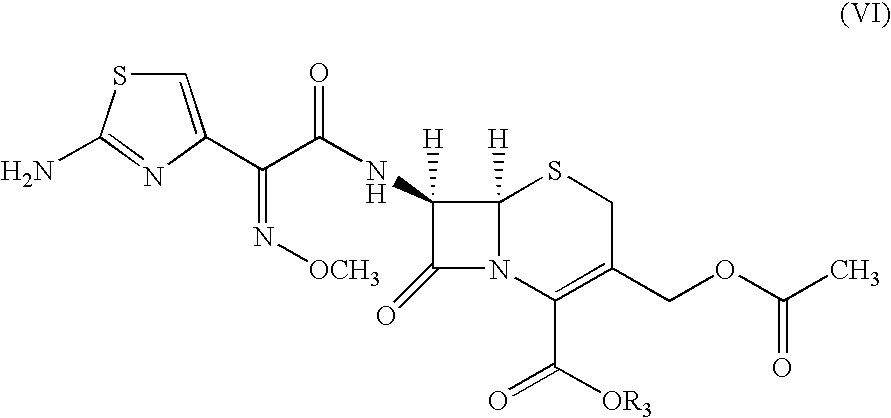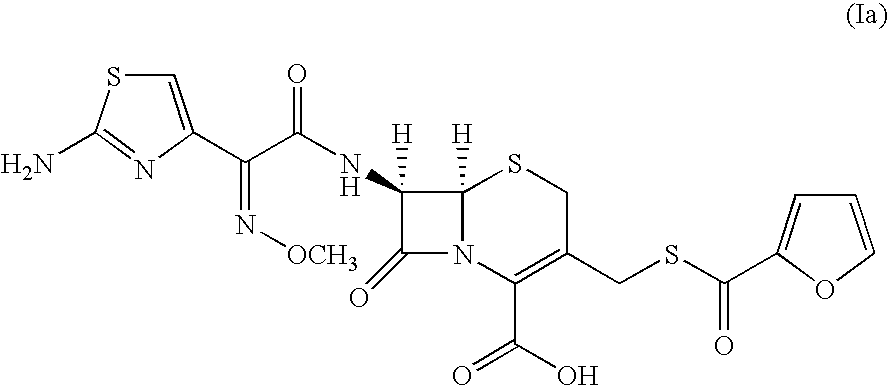Method for preparation of ceftiofur and salts thereof
a ceftiofur and salt technology, applied in the field of improvement, to achieve the effect of high stability
- Summary
- Abstract
- Description
- Claims
- Application Information
AI Technical Summary
Benefits of technology
Problems solved by technology
Method used
Image
Examples
example-1
Preparation of 7-[2-(2-amino-4-thiazolyl) glyoxylamido] 3-(mercaptomethyl)-8-oxo-5-thia-1-azabicyclo-[4.2.0]oct-2-ene-2-carboxylic acid (ceftiofur, Ia) from 7-[2-(2-amino-4-thiazolyl)-2-methoxyimino acetamido] cephalosporanic acid (cefotaxime, VI) using methanesulfonic acid
[0130]20.0 g (0.044 moles) of 7-[2-(2-amino-4-thiazolyl)-2-methoxyimino acetamido] cephalosporanic acid (cefotaxime; VI, wherein R3 is H) and acetonitrile (200 ml) was charged to a round bottom flask. The reaction mixture was cooled to 0-5° C. Methanesulfonic acid 62.0 g (0.643 moles) followed by thiofuroic acid (50.0 ml 0.066 moles) was added to the mixture and temperature raised to 10-15° C. Progress of the reaction was monitored by HPLC. After completion of reaction the reaction mixture was cooled to 0° C. and the precipitated solid was filtered and washed with 2×100 ml of ethyl acetate. The solid ceftiofur (Ia), thus obtained was taken in 200 ml of demineralized water, cooled to 10° C. and the pH was adjusted ...
example-2
Preparation of 7-[2-(2-amino-4-thiazolyl) glyoxylamido] 3-(mercaptomethyl)-8-oxo-5-thia-1-azabicyclo-[4.2.0]oct-2-ene-2-carboxylic acid (ceftiofur, Ia) from cefotaxime sodium (VI) using methanesulfonic acid
[0132]20 g (0.04192 moles) of cefotaxime sodium (VI, wherein R3 is Na) and acetonitrile (200 ml) were charged in a round bottom flask at room temperature. Methanesulfonic acid (62 g, 0.642 moles) was added slowly to the reaction mixture. Thiofuroic acid (50 ml; 0.066 moles) was added to the reaction mixture in a single lot. The reaction mixture was stirred for three hours. Progress of reaction was monitored by HPLC. The reaction mixture was cooled to 0° C. and the solid filtered and washed with 2×100 ml ethyl acetate. The wet ceftiofur (Ia) was taken in taken in 200 ml of demineralised water, cooled to 10° C. and pH of the solution was adjusted to 3.0 by 10% HCl. The solution was filtered and washed with demineralised water.
[0133]The wet solid, without drying was taken in 100 ml o...
example-3
Preparation of 7-[2-(2-amino-4-thiazolyl) glyoxylamido] 3-(mercaptomethyl)-8-oxo-5-thia-1-azabicyclo-[4.2.0]oct-2-ene-2-carboxylic acid (ceftiofur, Ia)) from 7-[2-(2-amino-4-thiazolyl)-2-methoxyimino acetamido] cephalosporanic acid (cefotaxime, VI) using methanesulfonic acid
[0134]100.0 g (0.22 moles) of 7-[2-(2-amino-4-thiazolyl)-2-methoxyimino acetamido] cephalosporanic acid (cefotaxime; VI, wherein R3 is H) and acetonitrile (1000 ml) was charged to a round bottom flask. The reaction mixture was cooled to 0-10° C. Methane sulfonic acid 318.1 g (96.4 moles) followed by dry thiofuroic acid in ethyl acetate (245.0 ml) was added. Temperature of the reaction mixture was maintained between −4 to −1° C. The reaction mixture was stirred for 6 hours at 5-10° C. The temperature was raised to 20 to 25° C. in 10-15 minutes time and stirring was continued for 60 minutes. Progress of reaction was monitored by HPLC. After completion of reaction the reaction mixture was filtered and washed with 2×...
PUM
| Property | Measurement | Unit |
|---|---|---|
| temperature | aaaaa | aaaaa |
| temperature | aaaaa | aaaaa |
| temperature | aaaaa | aaaaa |
Abstract
Description
Claims
Application Information
 Login to View More
Login to View More - R&D
- Intellectual Property
- Life Sciences
- Materials
- Tech Scout
- Unparalleled Data Quality
- Higher Quality Content
- 60% Fewer Hallucinations
Browse by: Latest US Patents, China's latest patents, Technical Efficacy Thesaurus, Application Domain, Technology Topic, Popular Technical Reports.
© 2025 PatSnap. All rights reserved.Legal|Privacy policy|Modern Slavery Act Transparency Statement|Sitemap|About US| Contact US: help@patsnap.com



